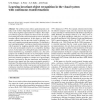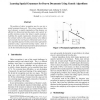229 search results - page 6 / 46 » Learning spatial relations in object recognition |
BC
2006
13 years 7 months ago
2006
Abstract The cerebral cortex utilizes spatiotemporal continuity in the world to help build invariant representations. In vision, these might be representations of objects. The temp...
NIPS
1997
13 years 9 months ago
1997
There is strong evidence that face processing is localized in the brain. The double dissociation between prosopagnosia, a face recognition deficit occurring after brain damage, a...
BMVC
1998
13 years 9 months ago
1998
We introduce an object recognition system in which objects are represented as a sparse and spatially organized set of local (bent) line segments. The line segments correspond to b...
ICPR
2010
IEEE
13 years 12 months ago
2010
IEEE
We present a fast and robust graph matching approach for 2D specific object recognition in images. From a small number of training images, a model graph of the object to learn is a...
HIS
2008
13 years 9 months ago
2008
The problem of object recognition may be cast into a spatial grammar framework. This system comprises three novel elements: a spatial organisation of line features, an efficient t...


